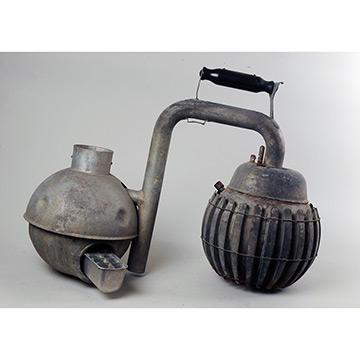Icy Ball Refrigeration Unit
Display:
Culinary Technique: heat transfer
Date: pat. 1929, 1931
Manufacturer: Crosley Radio Corporation
Location: Cincinnati, Ohio
Dimensions: 18" h x 26" w x 10" d
Watch collection donor Mel Mickevic demonstrate this object with
Dean Christopher
Koetke, School of Culinary Arts, Kendall College,
and Victoria Matranga, exhibition curator.
This absorption system refrigerated foods and even froze water to make ice cubes without using electricity. Instead, it relied on physical and chemical processes to harness the power of heat to produce cold.
The two spheres are connected by a U-shaped tube, whose interior includes valves and parts to control the circulation of steam and condensate as the liquids in the spheres were heated and cooled. First, the user hung the device over the edge of a water vat, with the larger sphere - the generator-absorber filled with water - suspended over a burner, and the smaller sphere - the evaporator-condenser filled with a refrigerant such as ammonia - immersed in the water. Flanged channels on the generator's surface functioned as fins to exchange heat by radiation or convection. As water in the generator sphere heated over the burner, the steam inside built pressure in the evaporator sphere as it vaporized the refrigerant, and the sphere gave up heat into the water. When water in the generator heated to the boiling point, a whistle blew to alert the user to move the device to a food storage cabinet. The generator sphere was suspended outside the cabinet with the evaporator inside. As the generator cooled, it drew heat from the evaporator sphere to chill the cabinet's interior.
Although touted as a "lightweight portable" device, the Icy Ball actually required some strength to lift and move it, and a user who had plenty of time to devote to cooling a small volume.






